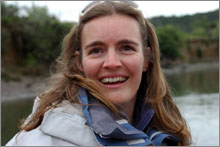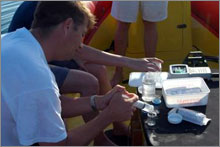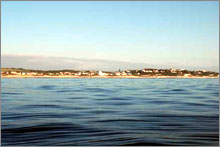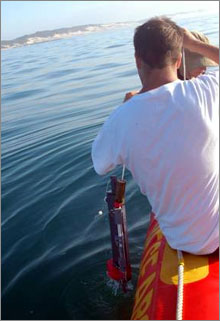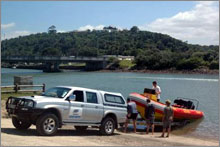Coastal upwelling studies can help piece together climate change puzzle
|
- By Dr Kim Bernard, Coastal Science and Data Coordinator, SAEON
Elwandle Node
If you’ve ever spent a summer holiday at one of the Eastern Cape beaches you’ll know about the dreaded easterly winds. They whip up a storm and can howl for days causing even the most intrepid beach explorer to stay huddled indoors.
The wind does eventually die down though and the summer sun comes out again and when you dash for the waves you find to your dismay that the water temperature has dropped by about 5 degrees! To beach-going holiday-makers this must be hell, but to a group of marine biologists from the Elwandle (marine coastal) Node of SAEON it is heaven.
“Dude, have you done you Christmas shopping?” My boss, Dr Angus Paterson, the manager of the Elwandle Node, is phoning me on Christmas Eve. “I’ve just been out diving and the water’s about 12 degrees at the surface! It’s upwelling! You’ve got to get out here!”
Now, my boss can call me up the day before Christmas and demand that I come to work because, well he’s my boss, but mainly because he’s actually volunteered to collect samples for me during his holiday. We are conducting a study on the effects that upwelling has on the nearshore marine environment off Port Alfred.
What is upwelling?
Upwelling is the term given to that phenomenon where cold, deep ocean water is transported to the surface. The physical drivers of coastal upwelling are complex and occur on different scales, but one of them is the wind, and in the Eastern Cape, easterly winds can cause coastal upwelling.
Other forces that drive coastal upwelling in the region include dynamic upwelling, where the Agulhas Current interacts with the continental shelf to cause deep ocean waters to move up onto the shelf. Sometimes this dynamic upwelling brings the cold deep ocean water right to the surface, but generally it is the easterly winds that have the final say, bringing the water and its nutrients to the surface.
Blooming phytoplankton and the coastal food chain
Apart from being substantially colder than the surface waters, the deep waters also contain higher concentrations of nutrients, which are essential for the growth and development of plant cells (known as phytoplankton), the basis of the marine food web. In the deep ocean, plant cells cannot make use of the nutrients because there is no light, but when the nutrients come to the surface during upwelling, there is the perfect combination of light and nutrition and the plant cells flourish in what is scientifically referred to as a phytoplankton bloom.
The fate of a phytoplankton bloom in the nearshore is quite complex; essentially, phytoplankton can either be eaten by grazing zooplankton, which are in turn preyed upon by larger zooplankton and fish larvae, which themselves are then eaten by planktivorous fish (fish that eat plankton), and so on; or, if washed into the intertidal region, phytoplankton can provide a source of nutrition to filter-feeding rocky-shore creatures, like mussels.
Some phytoplankton blooms are not eaten at all, but are left to sink to the sea floor where they are broken down by bacteria and are then eaten by detritivores, or bottom-feeders. Essentially, a bloom of phytoplankton equates to a large amount of food in some way or another for one of the many diverse marine systems, and ultimately sustains much of our marine food resources (including fish and shellfish).
Climate change implications
Events that drive phytoplankton blooms and higher trophic level productivity are therefore very important to understand, especially in the light of global climate change.
“Why?” you might ask.
Well, certain climatic events such as El Niño result in the reduction of the frequency and strength of easterly winds in South Africa. If the easterly winds do in fact drive, or at least enhance, the coastal upwelling at Port Alfred, then if they were less frequent in the future we could anticipate that coastal upwelling would not occur as often, blooms of phytoplankton might therefore be more scarce and this could potentially impact on a number of marine organisms, some of which we depend on for food.
The implications for such changes are unknown unless we have a handle on how the system functions right now. The research that we are doing will feed into a greater body of research being undertaken by a number of other scientists in the country and will contribute to an improved understanding of the functioning of our marine coastal systems.
So what are we doing?
Most of the research on the Port Alfred upwelling has focused further offshore and on its influence downstream, at the Agulhas Bank. Our study aims to understand the impacts of coastal upwelling on the nearshore ecosystem off Port Alfred. We will use remote sensing and wind data spanning a decade to identify trends in the timing of upwelling events and to see how often the upwelling events are, in fact, correlated with the easterly winds.
We will also conduct many more boat trips out of Port Alfred to collect water samples. During these trips we collect water from three different depths, which will be used to measure the biomass of phytoplankton, as well as the nutrient concentrations. We would expect that during upwelling both the phytoplankton biomass and nutrient concentrations would be higher than normal.
We also use a machine called an YSI multi-parameter probe that can be sent down to the bottom, continuously measuring temperature, salinity and a number of other physical and chemical parameters. Other variables such as primary productivity and zooplankton abundances will also be measured.
But since the ocean is never stagnant, our next question is “Where does the nutrient and phytoplankton rich water move once it is upwelled?”
We hope to find answers to this and many other questions over the next few years. This project is being run by the SAEON Elwandle Node in collaboration with a number of other institutes.
We would like to thank all those who helped out during the pilot study over the Christmas holidays; even the Head of SAEON, Johan Pauw, came out on a sampling trip!


